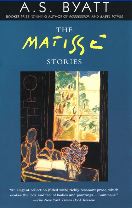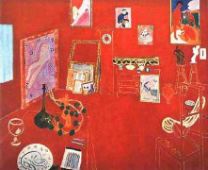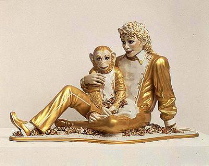
My friend Ann gave me a book recently, “The Matisse Stories,” by A.S. Byatt. It’s not a new book (1993) but the slim volume has three great art stories that I wolfed right down. ($8.80 at Amazon… and free at the library!) Byatt, of course, is all about obsession and people whose sensibilities are almost too finely attuned for our world (“Possession,” e.g.). Here, the stories are true to form but sneak their way into the business of art as well. Best for me was “Art Work” in which a married couple, Debbie and Robin (he’s a painter, she’s a magazine editor) and their housekeeper, Mrs Brown play out a cathartic moment in all their lives.
Debbie uses her connection with the magazine to arrange a visit by a gallery owner to her husband’s studio (in the hope of getting him an exhibit). The gallery owner, Shona, comes by and quickly gets this about Robin’s work: that she won’t be able to sell much of it because it all looks like the same picture painted again and again. She’s oblique in her comments to the artist and says the works might look to an untrained person like they were all pretty much the same work (one sunset after another; one still life set-up painted many times). (image below is Matisse‘s “Red Studio” 1911. I wonder what Shona would think of Matisse’s works, many of which seem repetitive.)

She asks Robin whether he ever thought of taking it in a new direction. He doesn’t get it and talks about light and shape and form and about painting more sunsets and still lifes and that’s the end of the meeting. On the way out Mrs. Brown runs after the gallery owner and talks with her briefly. And don’t you know, Mrs. Brown winds up getting the exhibit at the gallery! Turns out she’s a secret fabric installation artist and makes quirky, (needless to say, obsessive) patchwork environments full of embroidered detail — spider webs full of bejewelled objects. The gallery owner sees potential in the work (and marketability although how is never explained, but there you are it’s fiction). The show’s a hit and Mrs. Brown quits her cleaning job to become an artist full time. Robin and Debbie get a new housekeeper and ultimately Robin turns his bottled-up rage at being passed over in favor of his cleaning lady into something new, loose and fierce. And the new cleaning lady, who gets the last word, says about the new painting, “I do think he’s got something.”
The story is of course allegorical and full of wish fulfillment (who wouldn’t want to be discovered and rescued from cleaning houses and delivered into the world of making art full time and selling it to an audience that appreciates it…who doesn’t long for that moment of cathartic change no matter how painful). However, while the lesson about catharsis seems true, the lesson about the honest, hardworking but overlooked artist getting her reward, on the other hand, is great fiction — Hollywood fiction almost — but factually inaccurate.
Fact or fiction

More factual, indeed all facts, is the New Yorker Talk of the Town piece this week by Calvin Tompkins about Jeff Koons‘s 50th birthday party. Read it here. The piece has a kind of frog-prince in Neverland charm that almost strains credulity, but it’s all true.
Koons, described as one whose ego is so big, and whose projects are so vast and money-sucking that they require more than one gallery to achieve fruition, seems, notwithstanding a trail of bad dealings and art world shenanigans… everybody’s favorite. The golden boy. The art world power players came from all over to fete the boy at mid-century and treat him to his favorite meal — tuna burgers! Happiness was all around and even those previously feuding artists David Salle and Julian Schnabel were talking convivially again. How could you make this up?
Koons, whose work seems to get better with time, may wind up being our Michelangelo. Although instead of dancing to the tune of the piper (or patron) as the Rennaisance artist had to, Koons seems to be calling the shots and patrons are dancing in line waiting to buy. (image is “Michael and Bubbles” which, experienced live in a museum, is just too good, with all its allusions to Louis XIV gilt and Hummel figurines and wax museum figures and circus sideshows — it has thrilling contemporary and historical weirdness going for it like no other object.)
Big artist with big ego makes big noise and big money. It’s not a lesson I like but it seems to be the one that works today.









